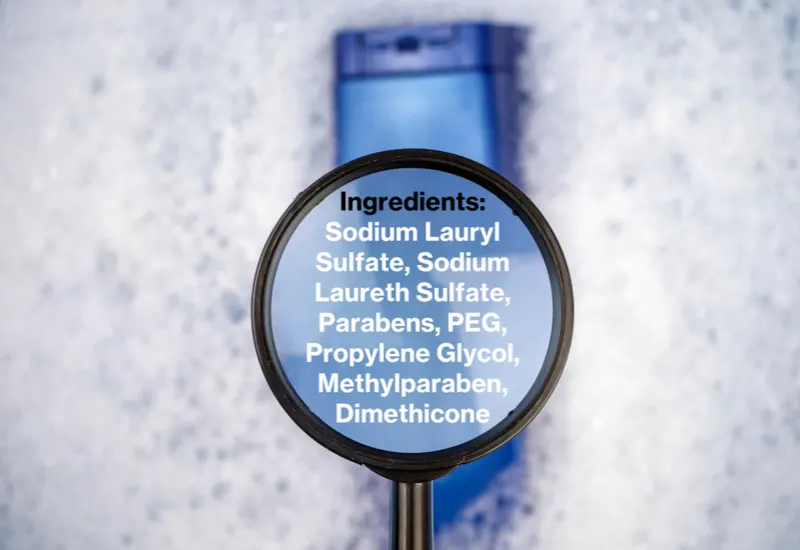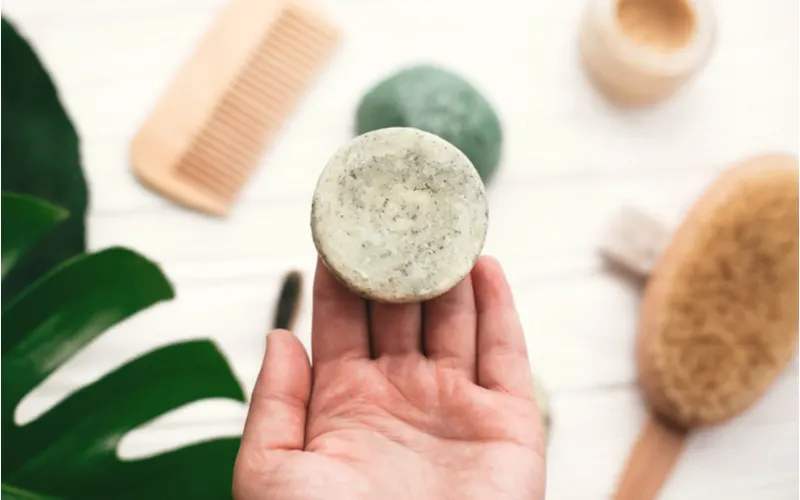Jump to:
Whether you’re struggling with dry hair or doing a health makeover in your life, learning what ingredients to avoid in shampoo is crucial. Below, we’ll highlight the worst ingredients you can put on your hair and why you should avoid each one.
What Ingredients Should You Avoid in Shampoo?
Some of the many ingredients you should avoid in shampoo include parabens, sulfates, and formaldehyde. But even ingredients like sodium chloride (salt) can take a toll on your hair.
There are many reasons you should care about the ingredients in your shampoo. Unnatural chemicals in shampoo can:
- Damage your hair
- Create serious health issues
- Cause harm to the environment
- Encourage animal testing
So, whether you’re experiencing respiratory issues during your shower or loss of hair, among many other scary symptoms, your shampoo might be the culprit.
10 Ingredients in Shampoo to Avoid

Alona Siniehina/Shutterstock
Read on to learn about the ingredients you should avoid in shampoos.
1. Parabens
Parabens (in shampoo) are a group of chemicals that serve as a preservative in hair products and other cosmetics. According to the Food and Drug Administration (FDA), the most common forms of parabens include:
- Butylparaben
- Ethylparaben
- Methylparaben
- Propylparaben
Why Parabens Are Bad for Your Hair
Shampoos commonly use parabens, but they’re harmful to your hair because they can cause hair loss. The reason for this is that this chemical can seek into your skin and scalp. The result is dry hair that can cause hair loss and color fade.
Dangers of Using Parabens
Aside from causing skin irritation and hair loss, parabens can create hormonal disruption.
That’s an especially serious concern for women using paraben shampoos, given that it can harm their reproductive organs and impact fertility. It can even affect childbirth. Furthermore, parabens raise the risk of cancer in people of all genders and ages.
Read Next: What Is the Ingredient in Shampoo that Causes Hair Loss?
2. Sulfates
Sulfates are responsible for giving your hair a squeaky-clean feel—they’re the reason shampoo lathers. Manufacturers also include sulfates in other cleaning products like dish soap.
Why Sulfates Are Bad for Your Hair
Sulfates are bad for hair because they clean so effectively that they end up stripping away too much oil from your scalp. As a result, your hair may become dry.
Over time, sulfates can also cause your hair to become too oily, given that your scalp may overcompensate for losing so much natural oil.
Dangers of Using Sulfates
Sulfates can cause a range of health issues in humans, including reduced lung function and asthmatic symptoms. There are also environmental concerns with using this chemical, given that it’s not an environmentally friendly topic and companies test many sulfate products on animals.
3. Formaldehyde
Formaldehyde is a gas that manufacturers use in everything from shampoo to medicine and antiseptics.
You can also find it as a food preserver, and humans even produce small amounts of formaldehyde as part of our metabolic process. Don’t worry about that part, though—it exits our bodies quickly, leaving us unharmed.
Why Formaldehyde Is Bad for Your Hair
Formaldehyde is bad for your hair because it’s a carcinogen. So, with repeated use of shampoos with formaldehyde, this toxic chemical could end up seeping into your scalp. A sign that your shampoo contains formaldehyde is if you see “quaternium-15” in its ingredient list.
Dangers of Using Formaldehyde
At best, frequent or prolonged exposure to formaldehyde in shampoos irritates the skin, nose, throat, and eyes. However, if you come in contact with it often, it can lead to cancer. In fact, since formaldehyde is a gas, some of it can even seep out of the shampoo bottle and into the air.
4. Synthetic Fragrances and Colors
The color and scent that many shampoos contain aren’t natural. Instead, shampoo companies make them using synthetics, which originate from petroleum or coal-tar sources. These have several harmful chemicals, including:
- Phthalates
- Benzophenone
- Styrene
Why Synthetic Frangrances and Colors Are Bad for Your Hair
Synthetic fragrances and colors can remove the natural oils from your hair. The result is something everyone wants to avoid, including dry or greasy hair, frizz, and tangling. You might also experience dandruff.
Dangers of Using Synthetic Fragrances and Colors
By using shampoo with synthetic fragrances and colors, you could wind up with an allergic reaction to it as a best-case scenario. But given that Benzophenone and styrene are carcinogens, they can cause cancer. You also might have endocrine issues as a result of phthalates.
5. Triclosan
The goal of using triclosan in shampoo is with good intentions—it kills and prevents bacteria. Currently, the FDA permits the use of triclosan in several consumer products, including toothpaste and some cosmetics.
Why Triclosan Is Bad for Your Hair
Depending on the person, using shampoo with triclosan can cause the following issues:
- Hair loss
- Scalp inflammation
- Dryness
Dangers of Using Triclosan
Triclosan has a laundry list of damaging effects on human health, with much of it revolving around a weakened immune and endocrine system. If you expose children to triclosan at a young age, they may also have a higher chance of developing asthma, eczema, and allergies.
6. Retinyl Palmitate
Retinyl palmitate is a type of vitamin A. You can encounter it in protein-based products like beef, chicken, and eggs. It’s a popular skin-conditioning ingredient and commonly comes in sunscreen.
Why Retinyl Palmitate Is Bad for Your Hair
We’ll admit that there are mixed reviews on how bad retinyl palmitate is for your hair. In fact, some people even go as far as to say that it can improve the scalp’s condition. However, we recommend steering clear of it, given that many users report issues with scalp peeling, itching, and redness.
Dangers of Using Retinyl Palmitate
Skin cancer is one of the most known issues with people who use retinyl palmitate, given that you can burn faster in the sun. That’s especially a concern if you use shampoo on balding hair, as your bald spot will have direct sun exposure.
7. Polyethylene Glycol
Polyethylene glycol is a polyether compound that food, cosmetic, and pharmaceutical companies use. It has a laxative effect, which is why you’ll see it in many medicines for constipation. Manufacturers use it in shampoos for its thickening property.
Why Polyethylene Glycol Is Bad for Your Hair
The damage that polyethylene glycol can cause to hair is significant, given that it acts as an absorber when you encounter toxic particles in the environment. As a result, the toxins can irritate your scalp and hair, leading to dryness, roughness, and brittleness.
Dangers of Using Polyethylene Glycol
The jury is still out on whether polyethylene glycol is a dangerous ingredient in shampoo, aside from its potential effect on your hair. Nevertheless, it’s best to err on the side of caution—its ethylene oxide and 1,4-dioxane by-products are harmful to human health.
8. Cocamidopropyl Betaine
Cocamidopropyl Betaine is a coconut-based product that helps products like shampoo feel thick and creamy. They produce this sticky yellow liquid by combining raw coconut oil with dimethylaminopropylamine.
Yes, it’s a mouthful! By breaking up the surface tension in water, cocamidopropyl betaine facilitates dirt and grease removal from hair.
Why Cocamidopropyl Betaine Is Bad for Your Hair
Because of how well it cleans hair, cocamidopropyl betaine can remove too much oil, leaving your hair feeling too dry or greasy from your scalp overproducing oil to compensate for it. Cocamidopropyl betaine can also spark eczema, which can result in an itchy, dandruff-like salp.
Dangers of Using Cocamidopropyl Betaine
Don’t let its coconut foundation fool you—cocamidopropyl betaine shouldn’t touch human skin. The reason for this is dimethylaminopropylamine, which can result in skin irritation and lacrimation.
As a result, reports of allergic reactions and skin sensitivity to shampoos containing cocamidopropyl betaine are common.
9. Sodium Chloride
Yes, you read that right—salt is an ingredient you should avoid in shampoos. Manufacturers include sodium chloride because it helps shampoo keep its thicker consistency long after opening the bottle.
Why Sodium Chloride Is Bad for Your Hair
If you have a sensitive scalp, sodium chloride may irritate it more, leading to the following issues:
- Dry hair
- Itchy scalp
- Hair loss
Should sensitivity not be an issue for you, it might be okay to use shampoo with sodium chloride. However, you’ll find many chemical-free shampoos without it.
Dangers of Using Sodium Chloride
Using sodium chloride in shampoo is the least harmful ingredient on this list. Although it can impact the suppleness of your hair, the reality is that putting salt on the outside of your body has few consequences compared to a high sodium chloride intake via food.
10. Dimethicone
The silicone-based dimethicone has many uses in society, from shampoos to primers to anti-itch products. You can find this ingredient in many moisturizers and creams because of its ability to smooth the appearance of fine lines.
Why Dimethicone Is Bad for Your Hair
When exploring what ingredients to avoid in shampoo, dimethicone isn’t the worst offender, given that it helps your hair stay hydrated by reducing water loss. Nevertheless, as a result of this, it can create unhealthy build-up at your roots and the following issues:
- Scalp irritation
- Greasy hair
- Hair loss
Dangers of Using Dimethicone
No known major health issues exist for using dimethicone. However, some people believe it can cause acne, given its barrier cap that it can put over hair and skin. Some dimethicone shampoo users also have an allergic reaction to this ingredient.
Frequently Asked Questions

Bogdan Sonjachnyj/Shutterstock
Do you still have doubts about what ingredients to avoid in shampoo? The answers below will help.
What shampoos don’t have bad ingredients?
Natural shampoos don’t contain bad ingredients that are unhealthy for your hair, body, and environment. Examples include Acure Curiously Clarifying and Tree to Tub Hair Growth shampoo.
What shampoos don’t have sulfate?
Shampoos without sulfate include SheaMoisture, Verb Ghost, and Davines Dede. By using these shampoos, you’ll avoid the dry skin and lung issues that sulfite shampoos often cause. Sulfate can also spark reduced lung function and asthma.
What ingredients should I avoid in shampoo that cause hair loss?
Sulfates and formaldehyde are often the biggest culprits of shampoo-induced hair loss. Therefore, you should choose a natural shampoo free of these harmful chemicals.
Which ingredient is best for hair growth?
Natural shampoos containing peppermint, lavender, or sage oil can all help contribute towards hair growth. Furthermore, aloe vera can also increase your hair’s growth rate. You should avoid all shampoo labeled as having synthetic fragrance.
How do you know if a shampoo is bad for your hair?
Brittle hair without shine and stunted growth are some signs that the shampoo you’re using is bad for your hair. Furthermore, it’s often hard to manage, as it’ll tangle more easily and have high porosity.
So, What Ingredients Should You Avoid in Shampoo?
Some of the most harmful ingredients you should avoid in shampoo include formaldehyde, parabens, and sulfates.
We understand the learning curve involved with memorizing these substances. But once you find a natural, chemical-free shampoo, we’re confident that your hair and health will thank you for it.
